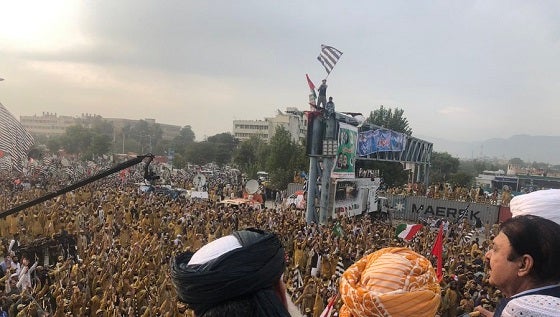Summary
On 31 October 2019, tens of thousands of anti-government protesters converged on Islamabad and have staged a sit-in protest since. It remains to be seen how the government and the military will respond to the protest. The ‘Azadi March’ is also a test of the opposition’s ability to pose a concerted challenge to the government.
On 31 October 2019, tens of thousands of anti-government protesters converged upon Pakistan’s capital, Islamabad. They have staged a dharna (sit-in protest) since arriving and are threatening not to leave till Prime Minister Imran Khan resigns.
Khan is accused of rigging the 2018 elections, which brought his Pakistan Tehreek-i-Insaf (PTI) party to power. Serious allegations have been levelled against the military of censoring the media during the electoral hustings to ensure the victory of the PTI. Leading news mediums such as GEO TV and Dawn complained about their coverage of the elections being curtailed.
The protesters have openly accused the military of placing Khan into power. Such open criticism of the military is significant, given the power it yields over the political sphere.
Khan is also blamed for mismanaging the economy. The PTI inherited an economy saddled with a crippling current account deficit and a depreciating currency. For months, the PTI government seemed to lack a coherent policy of dealing with the crisis. It was divided over how to balance implementing urgent economic and tax reforms and pursuing populist policies, such as creating 10 million jobs and building five million low cost housing units, which it had promised.
Eventually, the PTI decided to approach the International Monetary Fund (IMF) for help and a US$6 billion (SG$8.15 billion) bailout was agreed. This is contingent upon the Pakistani government making structural reforms and imposing austerity measures. Pakistan has agreed to privatise several state-owned industries, end subsidies on utility rates and expand the tax base with a view towards raising revenues. The government’s attempts to implement the above have already resulted in protests from traders across the country. In addition, rising energy prices have triggered public discontent. To make matters worse, inflation has almost tripled, since the PTI took power, to 11.4 per cent.
The current protest was initiated by the firebrand religious leader, Maulana Fazlur Rehman. He is the head of the political party, Jamiat Ulema Islam-Fazl (JUI-F). The two major opposition parties in Pakistan – the Pakistan Muslim League-Nawaz (PML-N) and Pakistan People’s Party (PPP) – have also begrudgingly supported the protest.
Termed the ‘Azadi March’ (March for Freedom), this protest is the first major challenge for Khan’s government. Addressing the protesters as they marched into Islamabad, Rehman declared that the protest will continue until “the end of this government”. The Chairman of the PPP, Bilawal Bhutto, echoed this demand when he stated in his speech welcoming the marchers to Islamabad that Khan was a figurehead “selected” by the military and that the people were not going to “bow before a selected figure or a dictator”.
The PTI government initially attempted to diffuse the threat posed by the Azadi March through police action and censorship. The JUI-F leader, Mufti Kifayatullah, was arrested. Another JUI-F leader, Hafiz Hamdullah, had his Pakistani citizenship revoked. The Pakistan Electronic Media Regulatory Authority issued orders stopping channels from airing Rehman’s news conferences. The government also placed shipping containers at important roads to block the protesters. The last two actions have been ruled illegal by the Peshawar High Court.
Given that Rehman has declared that it will be a “major sin” to retreat, the ability of the government and the military to handle the situation will be tested. The military has tried to extricate itself, albeit rhetorically, from the situation by stating that it supports “the democratically elected government” and not any political party.
Over the past year, the PTI government and the military have effectively employed media censorship. Television channels have often not broadcast news conferences by opposition parties and protests. For instance, a live interview with the PML-N’s Maryam Nawaz was taken off air midway. Similarly, mass protests in Waziristan against military action have largely gone unreported. Given the number of protesters involved, it remains to be seen how the government and the military respond to the dharna.
The Azadi March also poses a challenge to various opposition parties. The PML-N and the PPP have reluctantly supported the march. Both parties are concerned that the JUI-F may emerge as the face of the opposition. While the PML-N and the PPP leaders have supported the march and have addressed the protestors, they have yet to mobilise their supporters. Shahbaz Sharif, who is leading the PML-N, has been sceptical about the current protest. He chose not to meet Rehman when the latter arrived in Lahore on route to Islamabad.
Leaders of the three parties have held a series of talks but have yet to come to an agreement about strategy and aims. The lack of coordination has prevented the opposition from posing a serious challenge to the government. Mutual suspicion scuttled previous attempts by Rehman to reject the 2018 election results and to put up a common candidate in the 2018 Presidential election.
The coming days will provide clues to the shape of future political battles in Pakistan. It remains to be seen how the government and military will deal with this protest. Furthermore, we will get a sense of whether the opposition is able to make common cause.
….
Associate Professor Iqbal Singh Sevea is a Visiting Associate Research Professor at the Institute of South Asian Studies (ISAS), an autonomous research institute at the National University of Singapore (NUS). He can be contacted at iqbal@nus.edu.sg. The author bears full responsibility for the facts cited and opinions expressed in this paper.
-
 More From :
More From :
-
 Tags :
Tags :
-
 Download PDF
Download PDF



